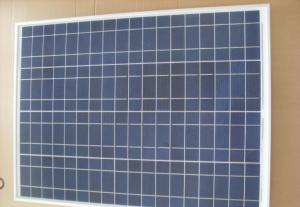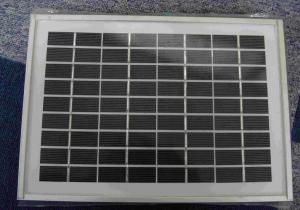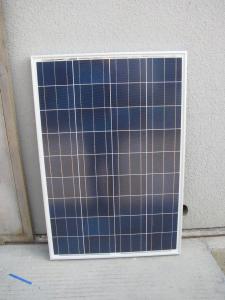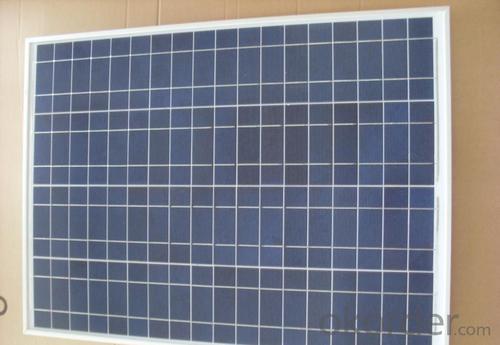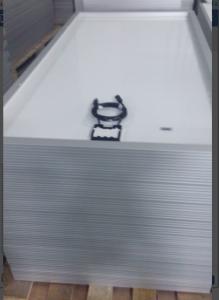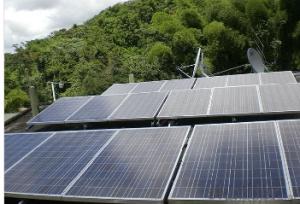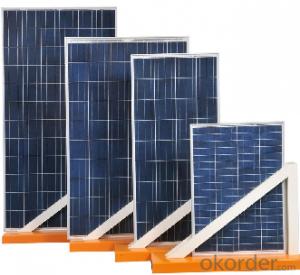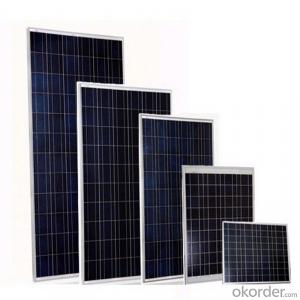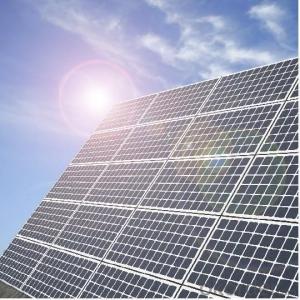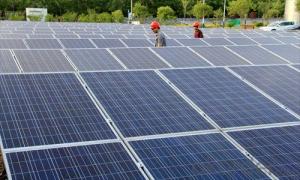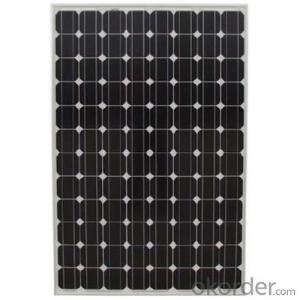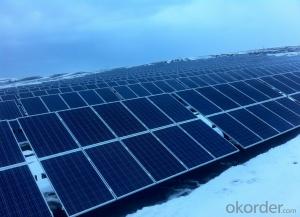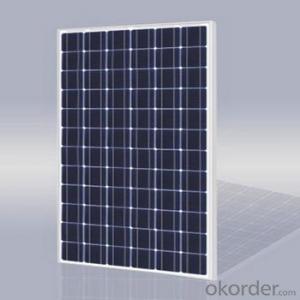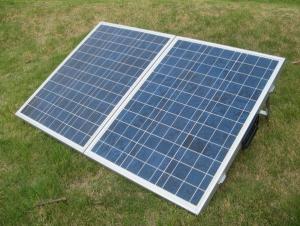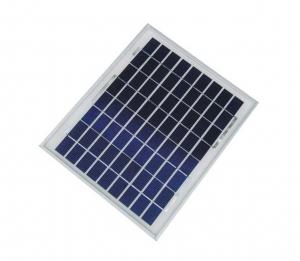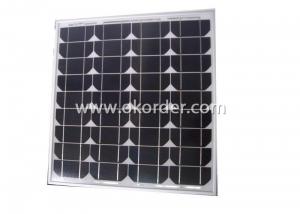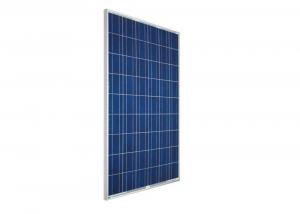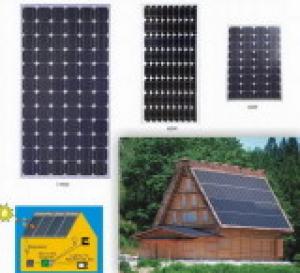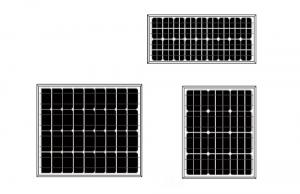Gopro Solar Panels - Solar Polycrystalline Panel (75w-95w)
- Loading Port:
- Shanghai
- Payment Terms:
- TT
- Min Order Qty:
- 1 pc
- Supply Capability:
- 100000/month pc/month
OKorder Service Pledge
OKorder Financial Service
You Might Also Like
Solar Polycrystalline Panel (75W-90W)
Introduction of Solar Polycrystalline Panel (75W-90W)
High-efficient solar cells ensure high performance and more power under same condition.
3.2mm high-transparent low-iron toughened glass, EVA laminate and water-proof TPT yield long life modules while enhancing cell performance.
Stable, heavy duty anodized aluminum frames with convenient mounting-access, for high wind pressure and snow load.
Bypass diodes to avoid hot-spot effect.
The backside of frames is equipped with drainage holes in order to eliminate the risk that rain or snow water may accumulate in the frame through and freeze or even bend the frame in cold season.
Characteristics of Solar Polycrystalline Panel (75W-90W)
I Solar Cell : High efficiency crystalline solar cell. Even if under the weak light, the solar module can produce maximum power output.
II Tempered glass (toughened glass): Anti-reflecting coating and high transmission rate glass increase the power output and mechanical strength of solar module.
III EVA and TPT: Using high quality EVA and TPT to prevent destroying and water.
IV AI frame: Without screw, corner connection. 6 holes on the frame can be installed easily.
V Junction box: Multi function junction box with water proof.
VI Long lifetime: ≥25 years; Less power decrease.
VII Good performance of preventing from atrocious weather such as wind and hails.
VIII Resisting moisture and etching effectively, not effected by geology.
Standard Test Conditions of Solar Polycrystalline Panel (75W-90W)
The opto-electrical specifications shown below are stabilized values being measured at Standard Test Conditions of multicrystalline silicon Solar Panel, Irradiance: 1000W/m2, Spectrum: AM1.5 at 25°C, The info below is subject to manufacturing tolerances. Where appropriate minutes of measurement are available and are used for the dimensioning of the installation.
Advantages of Solar Polycrystalline Panel (75W-90W)
• CNBM Solar performance guarantees for 25 years
• 2 years guarantee for workmanship for multicrystalline silicon Solar Panel
• Timeliness of delivery
Characteristics of Solar Polycrystalline Panel (75W-90W)
Max Power Voltage Vmp (V) | 17.4V | 17.6V | 17.2V | 17.6V | 18.0V |
Max Power Current Imp (A) | 4.31A | 4.55A | 4.94A | 5.11A | 5.28A |
Open Circuit Voltage Voc (V) | 22.0V | 22.2V | 21.8V | 22.2V | 22.6V |
Short Circuit Current Isc (A) | 4.73A | 4.87A | 5.29A | 5.48A | 5.53A |
Max Power Pm (W) | 75W | 80W | 85W | 90W | 95W |
Temperature Coefficient of Cells
NOCT | 47℃±2℃ |
Temperature Coefficients of Isc (%/℃) | 0.064 |
Temperature Coefficients of Voc (%/℃) | -0.33 |
Temperature Coefficients of Pmp (%/℃) | -0.45 |
Mechanical Data
Power | 75W/80W | 85W/90W/95W |
Dimension | 890×670×30mm | 1020×670×30mm |
Weight | 7.3kg | 8.3kg |
Tolerance | ±3% | ±3% |
The dimension of the modules can be changed according to the demand of clients
Limits of Solar Polycrytalline Panel (75W-90W)
Operating Temperature | –40 °C to +85°C |
Storage Temperature | –40 °C to +85°C |
Max System Voltage | 700V |
Guarantee of Solar Polycrystalline Panel (75W-90W)
Products Guarantee | 2 yrs free from defects in materials and workmanship |
Performance Guarantee | No less than 90% within 10yrs and no less than 80% within 20yrs |
Certificates | IEC, ISO, TUV, CE |
The Producing Equipment of Solar Polycrystalline Panel (75W-90W)
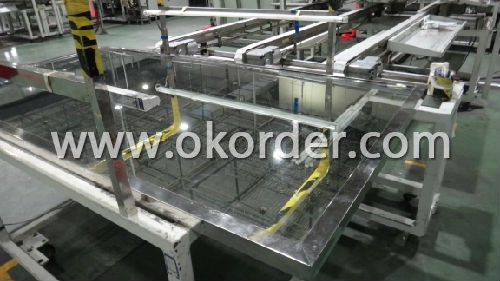
The Production Line of Solar Polycrystalline Panel (75W-90W)

- Q: Rooftop solar panel (not sure if rubber or plastic?) has leak arising from thin vertical crack in panel about long. Any ideas for repair?Thanks.
- Depending on the material and operating temperature of the panel, it MAY be possible to fix it very simply and easily by applying Hot Glue Gun adhesive over the cracked area. The high temperature glue gun adhesive melts at approximately 60 degrees Farenheit, and if the collector temperature does not quite reach, or exceed that operating temperature, then that repair method should work. Another possibility is an aerosol spray can product called LeakEnder. This is usually available at your local hardware store, or the major home improvement centers [like Lowe's, Sutherland's, Home Depot, McCoy's, etc.]. After preparing the area to be patched by cleaning, you just spray the LeakEnder patching material on the crack and an eighth of an inch or so around. IF the operating pressure or the collector is very low, it MAY even be possible to patch the leak with nothing more than a narrow strip of DUCT TAPE!!!!! Another possibility, but unless carefully accomplished is to weld the crack with a Soldering Gun and some scrap plastic from packaging material. The problem with this fix is that you must be very experienced in application of heat from the Soldering Gun, OR you will melt a larger hole in the collector tube than the crack was. Regardless of patching method, it is CRITICAL that the cracked area to be patched MUST be CLEAN and DRY BEFORE applying any patching material. Good luck!
- Q: I want to build solar panels for my house.Dose anyone try okorder is this really work?
- you okorder they have solar panels
- Q: hi so im doing a school project thing and they have a lot of different questions for us that help us decide whether we would rather a city have a nuclear reactor, or solar panel. But i cant seem to get the last 2 questions...help please???so question ........What types of emissions, if any, are produced by each type of generating station? Do these emissions affect human health?question 2.....What are the long term financial costs associated with maintaining each type of generating station?thanks!
- There's no standard nuclear reactor, but if we take a GW nuclear plant, it can generate about 8 terawatt-hours/year. A 200 watt solar panel can generate about kilowatt- hour/day, or 365 kwh/year, so that's about 2 million 200 watt solar panels. However, the power output from the nuclear plant is controllable by the operators, where solar panels only operate at full output for a few hours/day (on clear days - less if there's cloud). Therefore, to compare the two, you have to factor in some kind of energy storage or backup which will increase the cost of the solar installation (perhaps by a factor of two or more). Despite claims of solar being cheaper than coal now, when one compares apples to apples (i. e. total energy produced, and controllability) solar is still several times more expensive than coal, and about twice as expensive as nuclear even in the U. S. A gram of U-235 can make usable energy equal to three metric tons of coal. Solar energy production has no hazardous by-products, but manufacture of the panels can involve some very hazardous materials like fluorine (for silicon panels) or cadmium (for CdTe panels). This is part of the reason panel manufacture has gone to Asia - they have fewer environmental regulations and it's easier to dispose of the byproducts of production. DK
- Q: I thought that I had a fairly good understanding of watt's law, but i'm starting to doubt myself.If I have a load of 4500watts at 240 volts, how many watts of solar panels do I need, if the solar panels are at 2v?Yes, Yes... I have a charge controller, batteries, etc...So the way I looked at this at first:watts = volts * amps For the load4500 = 240 * xx would be 8.75aFor the power source (each solar panel)00 = 2 * xx would be 8.3a8.75 / 8.3 = 2.25, rounded up = 3So... based on that I came to the conclusion that I needed 3 solar panels...But... then I was thinking. Does it work that way?Or do I need 4500 / 00 = 45, aka 45 solar panels?In other words...If I have a 2v power source, how many watts do I need to drive a load of 4500w at 240v?ThanksMatt
- You okorder / Solar Pro Magazine another of their publications
- Q: My family and I are looking into solar panels for our home. But I'm unsure how it would be priced. This month our home used ,623 kwh. The solar panel company said we should expect $6-$9 per watt used. What would that put as at?
- With out doing the math,, I think I would ask the solar panel company to explain it to you as they are trying to sell it to you. And see if you have some sort of warranty of savings. Make them work for the sale!!
- Q: Solar panels single crystal and double crystal in the rain which is easy to use
- Polycrystalline silicon solar cell production process and monocrystalline silicon solar cell almost, but the polysilicon solar cell photoelectric conversion efficiency will have to reduce a lot of its photoelectric conversion efficiency of about 12% (July 1, 2004 Japan Sharp market efficiency of 14.8% Of the world 's most efficient polysilicon solar cells).
- Q: I'm making a model of a solar photovoltaic tower for a school project. I need a way to store energy, and we thought about using capacitors (mainly because of our somewhat limited funding). The tower will have a small photovoltaic panel (around the size of a laptop keyboard with number pad) and some (around 50) quot;heliostats(just the mirrors, no moving parts). What kind of capacitors should i use? and would a capacitor bank be better? i am getting confused with all those uF, pF and can't see the difference.Thanx in advance
- There okorder /
- Q: In nature, green leaves collect light and produce energy. Is this what they copied to make solar panels? If not how hard would it be to make artificial leaves that would power our homes?
- No, although they both use the capture of energy from electrons excited to a higher state by sunlight, plants use enzymes (mostly chlorophyll) packed in chloroplasts; solar panels still largely use silicon. There are some companies exploring the use of a plant enzyme-based process since it's so much more efficient. The farthest they've gotten is using organic nanocrystal pigments instead of silicon crystals.
- Q: Can solar panels be used to charge electric vehicles?
- Yes, solar panels can be used to charge electric vehicles. By harnessing the energy from the sun, solar panels can convert sunlight into electricity, which can then be used to charge the batteries of electric vehicles. This provides a sustainable and environmentally friendly way to power electric vehicles.
- Q: How many solar panels do you need on your house to power your heater in winter?
- You can get over 5 times the efficiency at lower cost by directly absorbing the heat in a solar water-heating collector. Use the electrical panels for making electricity for stuff that needs it.
Send your message to us
Gopro Solar Panels - Solar Polycrystalline Panel (75w-95w)
- Loading Port:
- Shanghai
- Payment Terms:
- TT
- Min Order Qty:
- 1 pc
- Supply Capability:
- 100000/month pc/month
OKorder Service Pledge
OKorder Financial Service
Similar products
Hot products
Hot Searches
Related keywords
